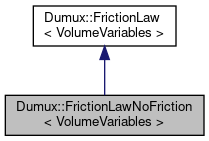A pseudo friction law with no bottom friction. More...
#include <dumux/material/fluidmatrixinteractions/frictionlaws/nofriction.hh>

A pseudo friction law with no bottom friction.
Public Member Functions | |
| FrictionLawNoFriction ()=default | |
| Constructor. More... | |
| Dune::FieldVector< Scalar, 2 > | shearStress (const VolumeVariables &volVars) const final |
| Compute the shear stress. More... | |
| Scalar | limitRoughH (const Scalar roughnessHeight, const Scalar waterDepth) const |
| Limit the friction for small water depth. More... | |
|
default |
Constructor.
|
inlineinherited |
Limit the friction for small water depth.
We define a water depth minUpperH. If the water depth is smaller, we start to limit the friciton. So the friciton term get's not extreme large for small water depths.
----------------------— minUpperH --------—
---------------------—roughnessHeight ------------— /\ /\ roughness /grain\ ----------------------------—bottom ---------------— /////////////////////////////////////////////////
For the limiting the LET model is used, which is usually applied in the porous media flow to limit the permeability due to the saturation. It employs the three empirical paramaters L, E and T, which describe the limiting curve (mobility).
auto mobility = (mobility_max * pow(sw,L))/(pow(sw,L) + E * pow(1.0-sw,T));
For the limitation of the roughness height L = 0.0, T = 2.0 and E = 1.0 are choosen. Therefore the calculation of the mobility is simplified significantly.
| roughnessHeight | roughness height of the representive structure (e.g. largest grain size). |
| waterDepth | water depth. |
< maximal mobility
|
inlinefinalvirtual |
Compute the shear stress.
| volVars | Volume variables |
Compute the shear stress due to friction. The shear stress is not a tensor as know from contiuums mechanics, but a force projected on an area. Therefore it is a vector with two entries. For this law without friction, the shearStress is zero.
Implements Dumux::FrictionLaw< VolumeVariables >.